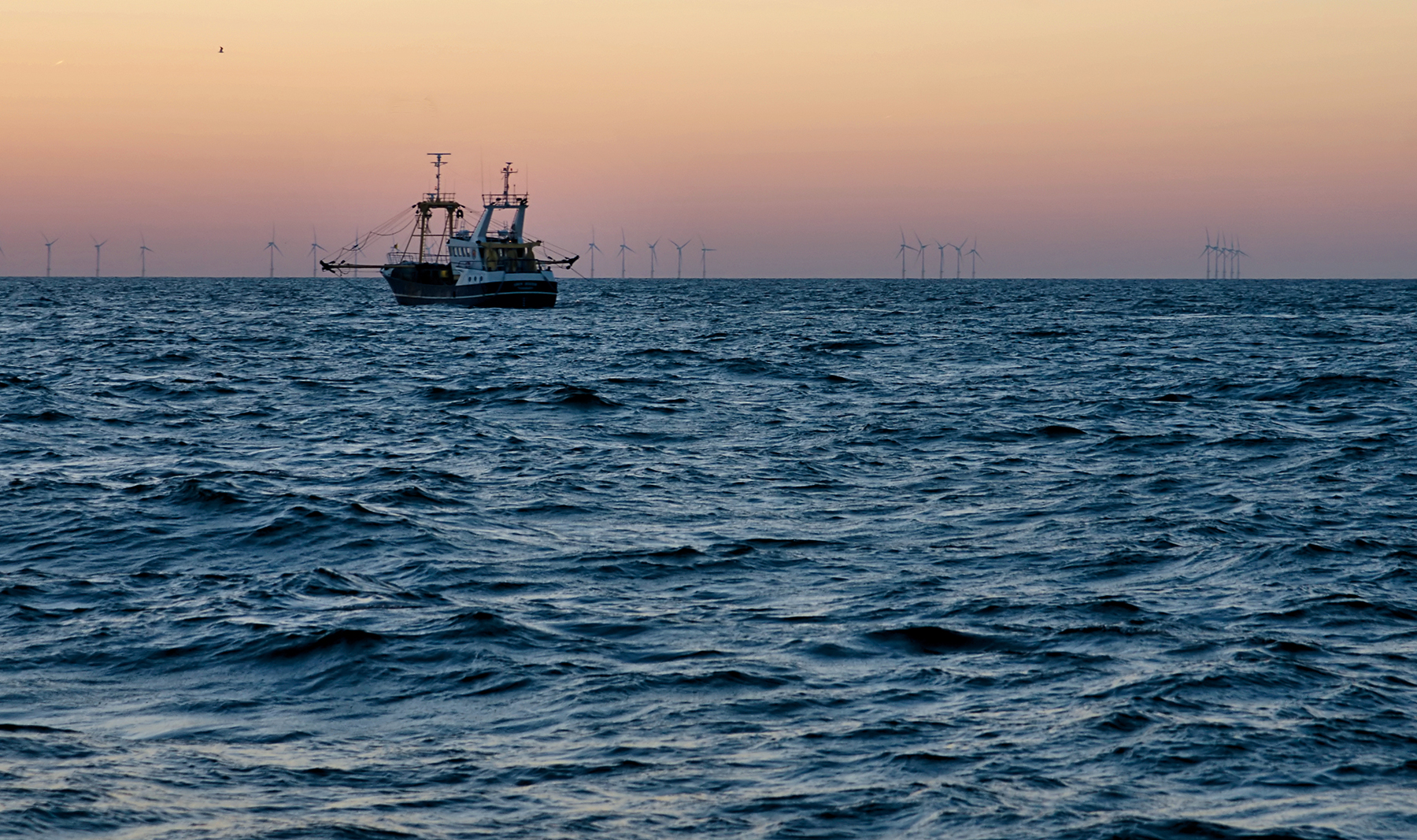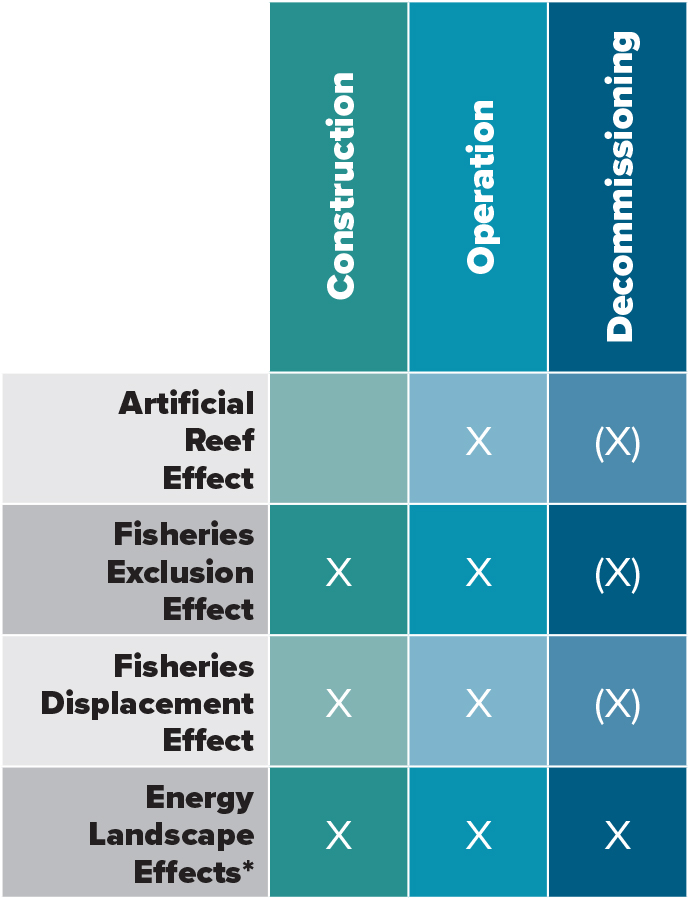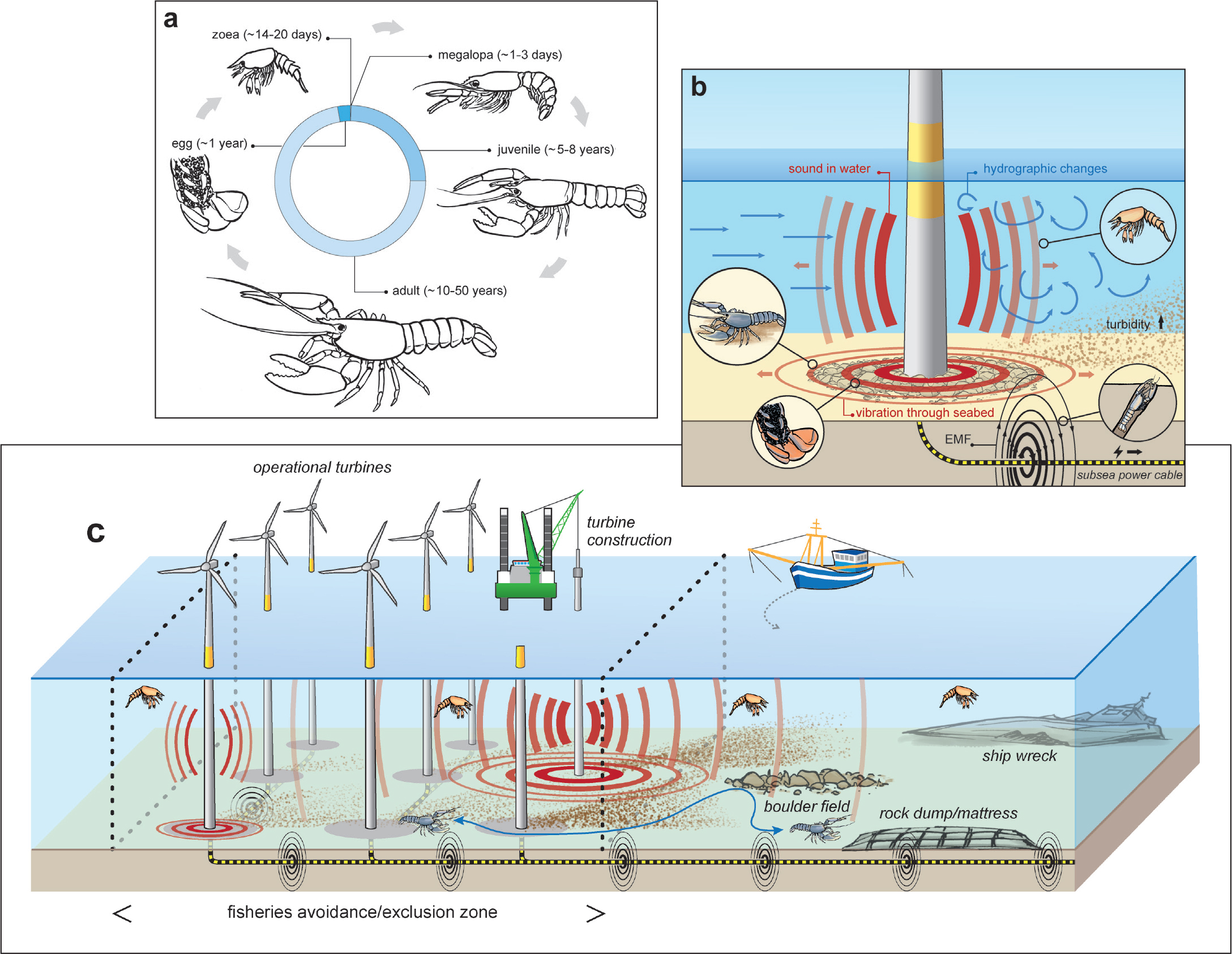Addison, P.F.E., L.B. Flander, and C.N. Cook. 2015. Are we missing the boat? Current uses of long-term biological monitoring data in the evaluation and management of marine protected areas. Journal of Environmental Management 149:148–56, https://doi.org/10.1016/j.jenvman.2014.10.023.
Ashley, M.C., S.C. Mangi, and L.D. Rodwell. 2014. The potential of offshore windfarms to act as marine protected areas–A systematic review of current evidence. Marine Policy 45:301–309, https://doi.org/10.1016/j.marpol.2013.09.002.
Barbut, L., B. Vastenhoud, L. Vigin, S. Degraer, F.A. Volckaert, and G. Lacroix. 2020. The proportion of flatfish recruitment in the North Sea potentially affected by offshore windfarms. ICES Journal of Marine Science 77(3):1,227–1,237, https://doi.org/10.1093/icesjms/fsz050.
Bergström, L., L. Kautsky, T. Malm, R. Rosenberg, M. Wahlberg, N.Å. Capetillo, and D. Wilhelmsson. 2014. Effects of offshore wind farms on marine wildlife—A generalized impact assessment. Environmental Research Letters 9(3):034012, https://doi.org/10.1088/1748-9326/9/3/034012.
Bohnsack, J.A. 1989. Are high densities of fishes at artificial reefs the result of habitat limitation or behavioral preference? Bulletin of Marine Science 44:631–645.
Botsford, L.W., J.C. Castilla, and C.H. Peterson. 1997. The management of fisheries and marine ecosystems. Science 277:509–515, https://doi.org/10.1126/science.277.5325.509.
Brickhill, M.J., S.Y. Lee, and R.M. Connolly. 2005. Fishes associated with artificial reefs: Attributing changes to attraction or production using novel approaches. Journal of Fish Biology 67:53–71, https://doi.org/10.1111/j.0022-1112.2005.00915.x.
Campbell, M., A. Pollack, T. Henwood, J. Provaznik, and M. Cook. 2012. Summary Report of the Red Snapper (Lutjanus campechanus) Catch During the 2011 Expanded Annual sSock Assessment (EASA). Southeast Data, Assessment, and Review, SEDAR31-DW17, 28 pp.
Carpenter, J.R., L. Merckelbach, U. Callies, S. Clark, L. Gaslikova, and B. Baschek. 2016. Potential impacts of offshore wind farms on North Sea stratification. PLoS ONE 11(8):e0160830, https://doi.org/10.1371/journal.pone.0160830.
Claisse, J.T., D.J. Pondella II, M. Love, L.A. Zahn, C.M. Williams, J.P. Williams, and A.S. Bull. 2014. Oil platforms off California are among the most productive marine fish habitats globally. Proceedings of the National Academy of Sciences of the United States of America 111(43):15,462–15,467, https://doi.org/10.1073/pnas.1411477111
Cooper, R.A., and J.R. Uzmann. 1980. Ecology of juvenile and adult Homarus. Pp. 97–142 in The Biology and Management of Lobsters, vol. II. J.S. Cobb and B.F. Phillips, eds, Academic Press, https://doi.org/10.1016/B978-0-08-091734-4.50010-X.
Daigle, S.T., J.W. Fleeger, J.H. Cowan, and P.-Y. Pascal. 2013. What is the relative importance of phytoplankton and attached macroalgae and epiphytes to food webs on offshore oil platforms? Marine and Coastal Fisheries: Dynamics, Management, and Ecosystem Science 5:53–64, https://doi.org/10.1080/19425120.2013.774301.
Dance, K.M., J.R. Rooker, J.B. Shipley, M.A. Dance, and R.J.D. Wells. 2018. Feeding ecology of fishes associated with artificial reefs in the northwest Gulf of Mexico. PLoS ONE 13:e0203873, https://doi.org/10.1371/journal.pone.0203873.
Dannheim, J., L. Bergström, S.N.R. Birchenough, R. Brzana, A. Boon, J. Coolen, J.-C. Dauvin, I. De Mesel, J. Derweduwen, and A. Gill. 2020. Benthic effects of offshore renewables: Identification of knowledge gaps and urgently needed research. ICES Journal of Marine Sciences 77:1,092–1,108, https://doi.org/10.1093/icesjms/fsz018.
De Backer, A., H. Polet, K. Sys, B. Vanelslander, and K. Hostens. 2019. Fishing activities in and around Belgian offshore wind farms: Trends in effort and landings over the period 2006-2017. Pp. 31–46 in Environmental Impacts of Offshore Wind Farms in the Belgian Part of the North Sea: Marking a Decade of Monitoring, Research and Innovation. S. Degraer, R. Brabant, B. Rumes, and L. Vigin, eds, Royal Belgian Institute of Natural Sciences.
Debusschere, E., B. De Coensel, A. Bajek, D. Botteldooren, K. Hostens, J. Vanaverbeke, S. Vandendriessche, K. Van Ginderdeuren, M. Vincx, and S. Degraer. 2014. In situ mortality experiments with juvenile sea bass (Dicentrarchus labrax) in relation to impulsive sound levels caused by pile driving of windmill foundations. PLoS ONE 9:e109280, https://doi.org/10.1371/journal.pone.0109280.
Degraer, S., R. Brabant, B. Rumes, and L. Vigin, eds. 2019. Environmental Impacts of Offshore Wind Farms in the Belgian Part of the North Sea: Marking a Decade of Monitoring, Research and Innovation. Royal Belgian Institute of Natural Sciences, OD Natural Environment, Marine Ecology and Management, Brussels, 134 pp.
Degraer, S., D.A. Carey, J.W.P. Coolen, Z.L. Hutchison, F. Kerckhof, B. Rumes, and J. Vanaverbeke. 2020. Offshore wind farm artificial reefs affect ecosystem structure and functioning: A synthesis. Oceanography 33(4):48–57, https://doi.org/10.5670/oceanog.2020.405.
De Mesel, I., F. Kerckhof, A. Norro, B. Rumes, and S. Degraer. 2015. Succession and seasonal dynamics of the epifauna community on offshore wind farm foundations and their role as stepping stones for non-indigenous species. Hydrobiologia 756:37–50, https://doi.org/10.1007/s10750-014-2157-1.
Dutch Ministry of Infrastructure and the Environment. 2016. Offshore Wind Energy Ecological Programme (WOZEP) Monitoring and Research Programme 2017–2021. Dutch Governmental Offshore Ecological Programme, 69 pp.
Floeter, J., J.E.E. van Beusekom, D. Auch, U. Callies, J. Carpenter, T. Dudeck, S. Eberle, A. Eckhardt, D. Gloe, K. Hänselmann, and others. 2017. Pelagic effects of offshore wind farm foundations in the stratified North Sea. Progress in Oceanography 156:154–173, https://doi.org/10.1016/j.pocean.2017.07.003.
Fowler, A.M., A.-M. Jørgensen, J.C. Svendsen, P.I. Macreadie, D.O.B. Jones, A.R. Boon, D.J. Booth, R. Brabant, E. Callahan, J.T. Claisse, and others. 2018. Environmental benefits of leaving offshore infrastructure in the ocean. Frontiers in Ecology and the Environment 16(10):571–578, https://doi.org/10.1002/fee.1827.
Gaines, S.D., C. White, M.H. Carr, and S.R. Palumbi. 2010. Designing marine reserve networks for both conservation and fisheries management. Proceedings of the National Academy of Sciences of the United States of America 107(43):18,286–18,293, https://doi.org/10.1073/pnas.0906473107.
Gill, A.B. 2005. Offshore renewable energy: Ecological implications of generating electricity in the coastal zone. Journal of Applied Ecology 42:605–615, https://doi.org/10.1111/j.1365-2664.2005.01060.x.
Gill, A.B., and D. Wilhelmsson. 2019. Fish. Chapter 5 in Wildlife and Wind Farms, Conflicts and Solutions, Vol. 3 Offshore: Potential Effects. M.R. Perrow, ed., Permagion Press.
Gill, A.B., S.N.R. Birchenough, A. Jones, A. Judd, S. Jude, A. Payo, and B. Wilson. 2018. Environmental implications of offshore energy. Pp. 132–169 in Offshore Energy and Marine Spatial Planning. K.L. Yates and C.J.A. Bradshaw, eds, London, Routledge, https://doi.org/10.4324/9781315666877-9.
Gill, A.B., and M. Desender. 2020. Risk to animals from electromagnetic fields emitted by electric cables and marine renewable energy devices. Pp. 86–103 in OES-Environmental 2020 State of the Science Report: Environmental Effects of Marine Renewable Energy Development Around the World. No. PNNL-29976CHPT5 Pacific Northwest National Lab, Richland, WA, 18 pp., https://doi.org/10.2172/1633088.
GWEC (Global Wind Energy Council). 2020. Global Offshore Wind Report 2020. 102 pp.
Gusatu, L.F., C. Yamu, C. Zuidema, and A. Faaij. 2020. A spatial analysis of the potentials for offshore wind farm locations in the North Sea region: Challenges and opportunities. ISPRS International Journal of Geo-Information 9(2):96, https://doi.org/10.3390/ijgi9020096.
Harrison, H.B., D.H. Williamson, R.D. Evans, G.R. Almany, S.R. Thorrold, G.R. Russ, K.A. Feldheim, L. Van Herwerden, S. Planes, M. Srinivasan, and others. 2012. Larval export from marine reserves and the recruitment benefit for fish and fisheries. Current Biology 22:1,023–1,028, https://doi.org/10.1016/j.cub.2012.04.008.
Hawkins, A.D., A.E. Pembroke, and A.N. Popper. 2015. Information gaps in understanding the effects of noise on fishes and invertebrates. Reviews in Fish Biology and Fisheries 25(1):39–64, https://doi.org/10.1007/s11160-014-9369-3.
Hooper, T., M. Ashley, and M. Austen. 2017. Capturing benefits: Opportunities for the co-location of offshore energy and fisheries. Pp. 189–213 in Offshore Energy and Marine Spatial Planning. K.L. Yates and C.J.A. Bradshaw, eds, Routledge, https://doi.org/10.4324/9781315666877-11.
Hutchison, Z.L., A.B. Gill, P. Sigray, H. He, and J.W. King. 2020a. Anthropogenic electromagnetic fields (EMF) influence the behaviour of bottom-dwelling marine species. Scientific Reports 10(1):1–15, https://doi.org/10.1038/s41598-020-60793-x.
Hutchison, Z.L., D.H. Secor, and A.B. Gill. 2020. The interaction between resource species and electromagnetic fields associated with electricity production by offshore wind farms. Oceanography 33(4):96–107, https://doi.org/10.5670/oceanog.2020.409.
Judd, A.D., T. Backhaus, and F. Goodsir. 2015. An effective set of principles for practical implementation of marine cumulative effects assessment. Environmental Science and Policy 54:254–262, https://doi.org/10.1016/j.envsci.2015.07.008.
Krone, R., L. Gutow, T. Brey, J. Dannheim, and A. Schroder. 2013. Mobile demersal megafauna at artificial structures in the German Bight—Likely effects of offshore wind farm development. Estuarine Coastal and Shelf Science 125:1–9, https://doi.org/10.1016/j.ecss.2013.03.012.
Krone, R., G. Dederer, P. Kanstinger, P. Krämer, and C. Schneider. 2017. Mobile demersal megafauna at common offshore wind turbine foundations in the German Bight (North Sea) two years after deployment—Increased production rate of Cancer pagurus. Marine Environmental Research 123:53–61, https://doi.org/10.1016/j.marenvres.2016.11.011.
Langhamer, O. 2012. Artificial reef effect in relation to offshore renewable energy conversion: State of the art. The Scientific World Journal 2012:1–8, https://doi.org/10.1100/2012/386713.
Large, S.I., G. Fay, K.D. Friedland, and J.S. Link. 2013. Defining trends and thresholds in responses of ecological indicators to fishing and environmental pressures. ICES Journal of Marine Science 70:755–767, https://doi.org/10.1093/icesjms/fst067.
Lester, S.E., B.S. Halpern, K. Grorud-Colvert, J. Lubchenco, B.I. Ruttenberg, S.D. Gaines, S. Airamé, and R.R. Warner. 2009. Biological effects within no-take marine reserves: A global synthesis. Marine Ecology Progress Series 384:33–46, https://doi.org/10.3354/meps08029.
Lindberg, W. J. 1997. Can science resolve the attraction-production issue? Fisheries 22:10–13.
Mavraki, N. 2020. On the Food-Web Ecology of Offshore Wind Farms, the Kingdom of Suspension Feeders. PhD thesis, Ghent University, 276 pp.
Methratta, E.T., and W.R. Dardick. 2019. Meta-Analysis of Finfish Abundance at Offshore Wind Farms. Reviews in Fisheries Science & Aquaculture 27:242–260, https://doi.org/10.1080/23308249.2019.1584601.
Methratta, E.T., A. Hawkins, B.R. Hooker, A. Lipsky, and J.A. Hare. 2020. Offshore wind development in the Northeast US Shelf Large Marine Ecosystem: Ecological, human, and fishery management dimensions. Oceanography 33(4):16–27, https://doi.org/10.5670/oceanog.2020.402.
Moland, E., E.M. Olsen, H. Knutsen, J.A. Knutsen, S.E. Enersen, C. André, and N.C. Stenseth. 2011. Activity patterns of wild European lobster Homarus gammarus in coastal marine reserves: Implications for future reserve design. Marine Ecology Progress Series 429:197–207, https://doi.org/10.3354/meps09102.
Mooney, T.A., M.H. Andersson, and J. Stanley. 2020. Acoustic impacts of offshore wind energy on fishery resources: An evolving source and varied effects across a wind farm’s lifetime. Oceanography 33(4):82–95, https://doi.org/10.5670/oceanog.2020.408.
Murawski, S.A., S.E. Wigley, M.J. Fogarty, P.J. Rago, and D.G. Mountain. 2005. Effort distribution and catch patterns adjacent to temperate MPAs. ICES Journal of Marine Science 62:1,150–1,167, https://doi.org/10.1016/j.icesjms.2005.04.005.
O’Keeffe, A., and C. Haggett. 2012. An investigation into the potential barriers facing the development of offshore wind energy in Scotland: Case study – Firth of Forth offshore wind farm. Renewable and Sustainable Energy Reviews 16:3,711–3,721, https://doi.org/10.1016/j.rser.2012.03.018.
Paxton, A., K. Shertzer, N. Bacheler, T. Kellison, K. Riley, and J. Taylor. 2020. Meta-analysis reveals artificial reefs can be effective tools for fish community enhancement but are not one-size-fits-all. Frontiers in Marine Science 7, https://doi.org/10.3389/fmars.2020.00282.
Popper, A.N., and A.D. Hawkins. 2019. An overview of fish bioacoustics and the impacts of anthropogenic sounds on fishes. Journal of Fish Biology 94(5):692–713, https://doi.org/10.1111/jfb.13948.
Raoux, A., S. Tecchio, J.-P. Pezy, G. Lassalle, S. Degraer, D. Wilhelmsson, M. Cachera, B. Ernande, C. Le Guen, M. Haraldsson, and others. 2017. Benthic and fish aggregation inside an offshore wind farm: Which effects on the trophic web functioning? Ecological Indicators 72:33–46, https://doi.org/10.1016/j.ecolind.2016.07.037.
Reeves, D.B., E.J. Chesney, R.T. Munnelly, D.M. Baltz, and K. Maiti. 2019. Trophic ecology of sheepshead and stone crabs at oil and gas platforms in the Northern Gulf of Mexico’s hypoxic zone. Transactions of the American Fisheries Society 148:324–338, https://doi.org/10.1002/tafs.10135.
Reubens, J.T., S. Degraer, and M. Vincx. 2014. The ecology of benthopelagic fishes at offshore wind farms: A synthesis of 4 years of research. Hydrobiologia 727:121–136, https://doi.org/10.1007/s10750-013-1793-1.
Roberts, L., and M. Elliott. 2017. Good or bad vibrations? Impacts of anthropogenic vibration on the marine epibenthos. Science of the Total Environment 595:255–268, https://doi.org/10.1016/j.scitotenv.2017.03.117.
SCEMFIS (Science Center for Marine Fisheries). 2020. Review of “Vineyard Wind 1 Offshore Wind Energy Project Supplement to the Draft Environmental Impact Statement.” E.N. Powell, ed., https://scemfis.org/wp-content/uploads/2020/07/wind_report_final-1.pdf.
Schulze, A., D.L. Erdner, C.J. Grimes, D.M. Holstein, and M.P. Miglietta. 2020. Artificial reefs in the Northern Gulf of Mexico: Community ecology amid the “ocean sprawl.” Frontiers in Marine Science 7:447, https://doi.org/10.3389/fmars.2020.00447.
Stuiver, M., K. Soma, P. Koundouri, S. Van den Burg, A. Gerritsen, T. Harkamp, N. Dalsgaard, F. Zagonari, R. Guanche, J.-J. Schouten, and others. 2016. The governance of multi-use platforms at sea for energy production and aquaculture: Challenges for policy makers in European seas. Sustainability 8(4):333, https://doi.org/10.3390/su8040333.
Taormina, B., J. Bald, A. Want, G. Thouzeau, M. Lejart, N. Desroy, and A. Carlier. 2018. A review of potential impacts of submarine power cables on the marine environment: Knowledge gaps, recommendations and future directions. Renewable and Sustainable Energy Reviews 96:380–391, https://doi.org/10.1016/j.rser.2018.07.026.
van Berkel, J., H. Burchard, A. Christensen, L.O. Mortensen, O. Svenstrup Petersen, and F. Thomsen. 2020. The effects of offshore wind farms on hydrodynamics and implications for fishes. Oceanography 33(4):108–117, https://doi.org/10.5670/oceanog.2020.410.
Wahle, R.A. 1992. Body-size dependent anti-predator mechanisms of the American lobster. Oikos 65(1):52–60, https://doi.org/10.2307/3544887.
Wang, J., X. Zou, W. Yu, D. Zhang, and T. Wang. 2019. Effects of established offshore wind farms on energy flow of coastal ecosystems: A case study of the Rudong offshore wind farms in China. Ocean and Coastal Management 171:111–118, https://doi.org/10.1016/j.ocecoaman.2019.01.016.
Wilding, T.A., A.B. Gill, A. Boon, E. Sheehan, J.C. Dauvin, J.P. Pezy, F. O’Beirn, U. Janas, L. Rostin, and I. De Mesel. 2017. Turning off the DRIP (‘Data-rich, information-poor’)–Rationalising monitoring with a focus on marine renewable energy developments and the benthos. Renewable and Sustainable Energy Reviews 74:848–859, https://doi.org/10.1016/j.rser.2017.03.013.
WindEurope. 2020. Offshore Wind in Europe, Key Trends and Statistics 2019. WindEurope, Brussels, Belgium, 40 pp.
Worm, B., R. Hilborn, J.K. Baum, T.A. Branch, J.S. Collie, C. Costello, M.J. Fogarty, E.A. Fulton, J.A. Hutchings, S. Jennings, and others. 2009. Rebuilding global fisheries. Science 325:578–585, https://doi.org/10.1126/science.1173146.
Wright, G., A.M. O’Hagan, J. de Groot, Y. Leroy, N. Soininen, R. Salcido, M.A. Castelos, S. Jude, J. Rochette, and S. Kerr. 2016. Establishing a legal research agenda for ocean energy. Marine Policy 63:126–134, https://doi.org/10.1016/j.marpol.2015.09.030.





